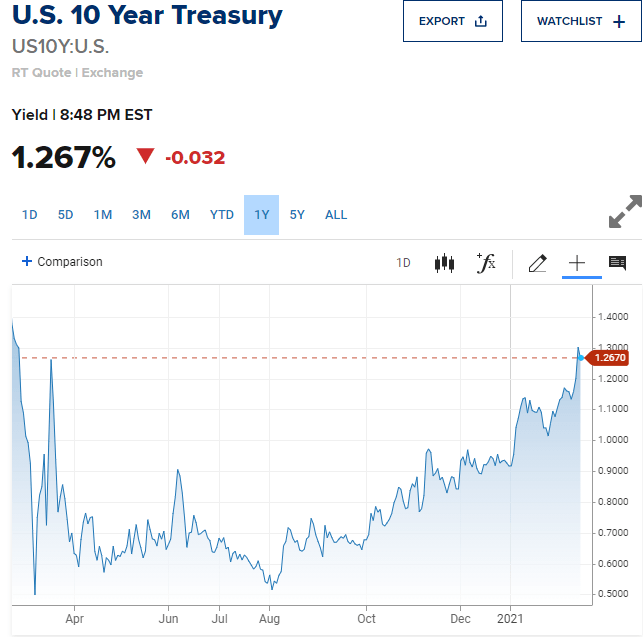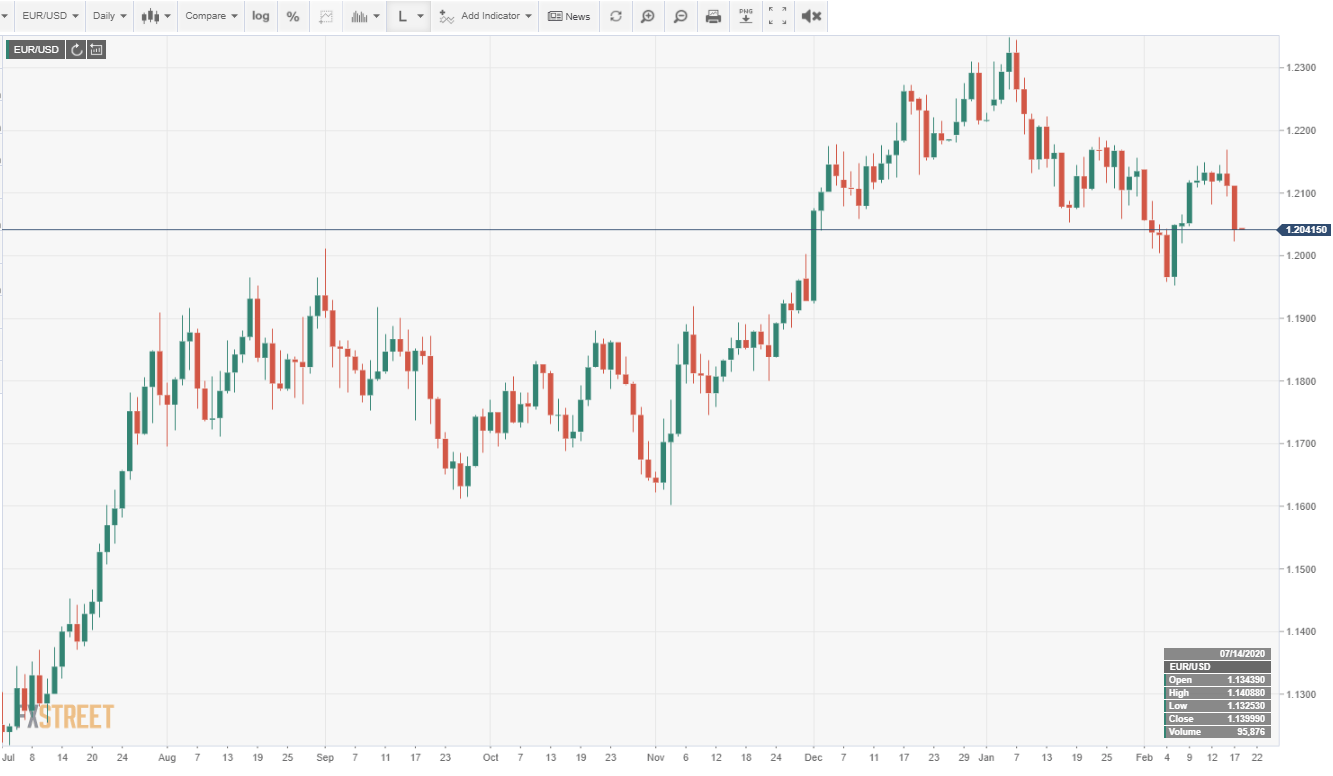- US economy remains “far from” the Fed's job and inflation goals.
- FOMC minutes expect “some time for substantial progress to be achieved.”
- Minutes ignored Treasury yields rising in anticipation of a US recovery.
- Dollar has gained on the back of Treasury rates.
Federal Reserve members at the January meeting did not expect rapid progress in returning the economy to its state before the pandemic began, confirming that monetary policy will remain accommodative for the foreseeable future.
The edited minutes of the January 26-27 Federal Reserve Open Market Committee meeting avoided the most pressing question for the financial markets. How far will the Fed let Treasury rates rise before it intervenes to dampen yield appreciation?
“Participants noted that the economic conditions were currently far from the Committee's longer-run goals,” recorded the official rendering of the discussions. “Consequently, all participants supported maintaining the Committee's current setting and out-come based guidance for the federal funds rate and the pace of asset purchases.”
Treasury yields
However, since that late January assessment bond yields have taken flight.
At the close of the December 16 FOMC meeting the 10-year Treasury was at 0.92%. By the January 27 conclave the return on this benchmark bond had gained nine basis points to 1.01%.
As the Fed is buying $80 billion in Treasuries each month perhaps it is more accurate to say the Fed acquiesced in the increase by not targeting bonds at the decade term to maintain a lower rate.
In the three weeks since the January FOMC the 10-year Treasury has added 30 basis points. The yield finished at 1.31% Tuesday before the release of the minutes. That was the highest for this commercial touchstone since February 26, 2020, before the Fed upended markets with its pandemic intervention.
CNBC
The yield retreated five points on Wednesday to 1.26%.
Whatever the governors' views on the appropriate market rates were at the January meeting it is evident that yields have not, despite the continued appreciation, reached the level that the Fed considers inimical to the recovery.
The dollar has been a modest beneficiary of the January and February rise in US interest rates.
Tapering and inflation
Before the January 27 FOMC market speculation thought the Fed might be seeking to define the criteria or timetable for tapering its bond purchases. When no policy change was suggested in the FOMC statement and Chairman Jerome Powell said in the question and answer after the meeting that rates would likely stay accommodative, the consideration died.
Since the January meeting, Fed officials from the Chairman down, have been united in saying that they do not anticipate any substantial policy changes until there is progress in the labor market.
The central bank's new inflation averaging policy will permit prices to run ahead of their 2% target for an unspecified time before even considering a restraining rate increase. The purpose of this new guidance was to prevent the reactive market increases in interest rates historically brought on by rising inflation.
Inflation is not the only economic signal watched by credit markets.
With the sharp increase in the commercially sensitive 10-year Treasury yield in the past three weeks, the Fed may soon have to temporize between the natural market inclination for higher rates as the economy speeds up, and its own stated goal of progress before tapering
Or maybe, the governors will choose the inflation angle, and redefine “substantial" labor market progress.
Information on these pages contains forward-looking statements that involve risks and uncertainties. Markets and instruments profiled on this page are for informational purposes only and should not in any way come across as a recommendation to buy or sell in these assets. You should do your own thorough research before making any investment decisions. FXStreet does not in any way guarantee that this information is free from mistakes, errors, or material misstatements. It also does not guarantee that this information is of a timely nature. Investing in Open Markets involves a great deal of risk, including the loss of all or a portion of your investment, as well as emotional distress. All risks, losses and costs associated with investing, including total loss of principal, are your responsibility. The views and opinions expressed in this article are those of the authors and do not necessarily reflect the official policy or position of FXStreet nor its advertisers. The author will not be held responsible for information that is found at the end of links posted on this page.
If not otherwise explicitly mentioned in the body of the article, at the time of writing, the author has no position in any stock mentioned in this article and no business relationship with any company mentioned. The author has not received compensation for writing this article, other than from FXStreet.
FXStreet and the author do not provide personalized recommendations. The author makes no representations as to the accuracy, completeness, or suitability of this information. FXStreet and the author will not be liable for any errors, omissions or any losses, injuries or damages arising from this information and its display or use. Errors and omissions excepted.
The author and FXStreet are not registered investment advisors and nothing in this article is intended to be investment advice.
Recommended Content
Editors’ Picks

AUD/USD clings to recovery gains above 0.6200, focus shifts to US ISM PMI
AUD/USD sustains the recovery from two-year troughs, holding above 0.6200 in Friday's Asian trading. The pair finds footing amid a pause in the US Dollar advance but the upside appears elusive as markets turn cautious amid China concerns and ahead of US ISM PMI data.

USD/JPY eases toward 157.00 as risk sentiment sours
USD/JPY is extending pullback from multi-month high of 158.07 set on Thursday. The pair drops toward 157.00 in the Asian session on Friday, courtesy of the negative shift in risk sentiment. Markets remain concerned about China's econmic health and the upcoming policies by the Fed and the BoJ.

Gold price appreciates amid Biden's discussions about potential strikes on Iran
Gold price edges higher for the fourth consecutive session on Friday, building on a stellar performance in 2024 with gains exceeding 27%, the metal’s best annual return since 2010. This sustained rally is attributed to strong safe-haven demand amid persistent geopolitical tensions in the Middle East and the prolonged Russia-Ukraine conflict.

Could XRP surge to new highs in January 2025? First two days of trading suggest an upside bias
Ripple's XRP is up 7% on Thursday, extending its rally that began during the New Year's Day celebration. If long-term holders continue their recent accumulation, XRP could overcome the $2.9 resistance level and aim for a new all-time high.

Three Fundamentals: Year-end flows, Jobless Claims and ISM Manufacturing PMI stand out Premium
Money managers may adjust their portfolios ahead of the year-end. Weekly US Jobless Claims serve as the first meaningful release in 2025. The ISM Manufacturing PMI provides an initial indication ahead of Nonfarm Payrolls.

Best Forex Brokers with Low Spreads
VERIFIED Low spreads are crucial for reducing trading costs. Explore top Forex brokers offering competitive spreads and high leverage. Compare options for EUR/USD, GBP/USD, USD/JPY, and Gold.

